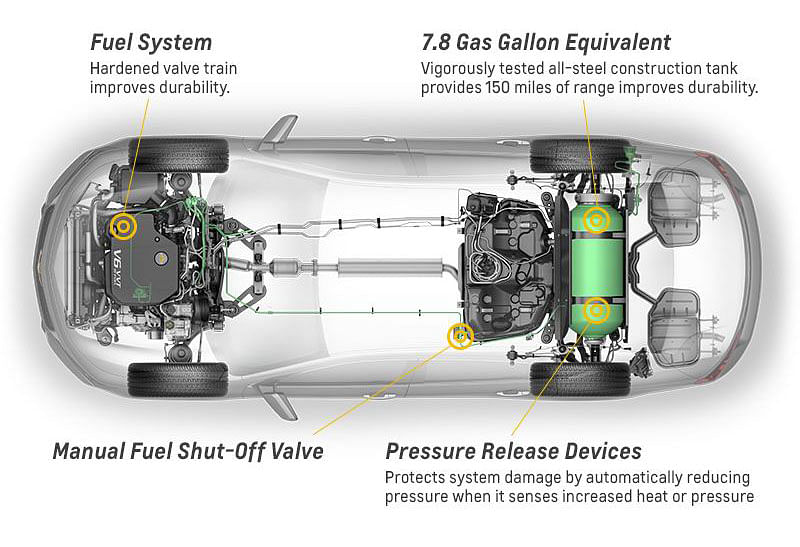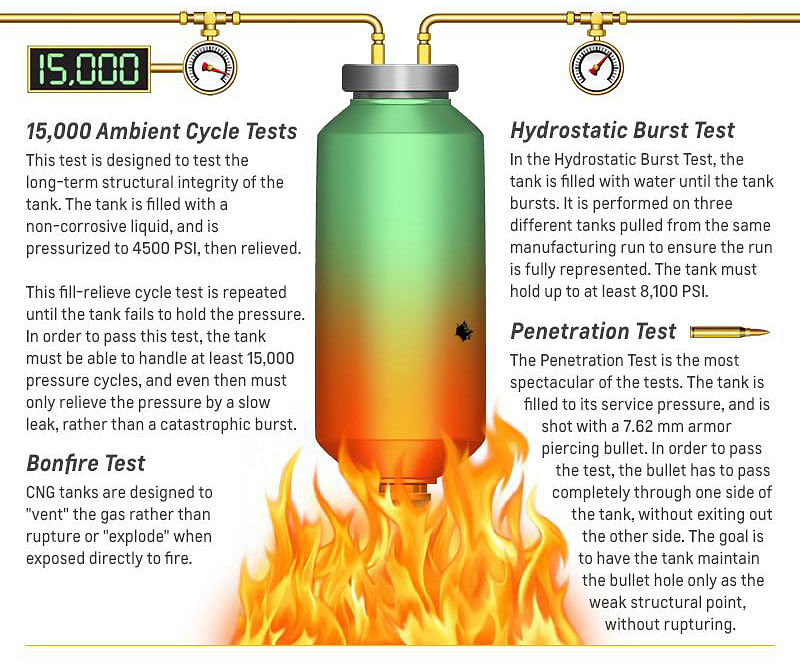Bi-fuel Chevrolet Impala tested with bullets and bonfires
Being able to take a bullet and withstand fires from multiple directions sets apart the compressed natural gas (CNG) tank
Being able to take a bullet and withstand fires from multiple directions sets apart the compressed natural gas (CNG) tank in the 2015 Bi-fuel Chevrolet Impala from less-strenuous testing of other natural gas-powered vehicles.
A large piece of cast aluminium helps protect the tank valve and connection from certain side impacts. Sheet metal plates on either side of the tank help protect it from loose objects in the trunk or rear seat.
“We designed this system for those ‘what if’ situations,” said Nichole Kraatz, Impala chief engineer. “The customer shouldn’t even know it’s there. They shouldn’t even think about it. CNG should just be another fuel they use to power their vehicle.”

Durability and safety testing at the tank’s normal operating pressure of 3,600 psi and higher subjected it to normal and extreme situations, exceeding federal requirements and CNG industry guidelines. For example:
- The industry-standard Bonfire Test confirms the CNG tank’s pressure relief valves are operational and help prevent the tank from rupturing in a fire. In addition to placing the tank about four inches above a steady 800-degree Fahrenheit fire, General Motors’ engineers added trunk, back seat and underbody fires to test the pressure relief valves’ ability to sense heat on all sides of the tank. And the tests were done at two different fuel levels.

- In the Penetration Test, the tank is filled to its service pressure and is shot with a 7.62 mm armour piercing bullet. In order to pass the test, the bullet has to pass completely through one side of the tank without exiting out the other side. The goal is to have the tank maintain the bullet hole only as the weak structural point, without rupturing.
- Front barrier, side impact and rear impact crash tests were conducted on the Bi-Fuel Impala. Some aftermarket CNG-conversion kit manufacturers conduct only a barrier test.
The tank also undergoes long-term structural integrity tests equivalent to 15,000 pressure cycles and hydrostatic bursting tests of up to 8,100 psi.
The Bi-fuel Impala – a 2015 ‘Green Car of the Year’ finalist – is the auto-industry’s only manufacturer-produced full-size sedan in North America that runs on both CNG and petrol. It is available to order now through all Chevrolet dealerships in the US and Canada with delivery expected at the end of this year.
The all-steel trunk-mounted CNG tank holds approximately 7.8 gallons, sufficient for about 150 miles/240 kilometres of driving after which the Impala seamlessly switches to petrol power.
RELATED ARTICLES
Skoda begins sale of made-in-India CKD Kushaq in Vietnam
Before production started, pre-series Kushaq vehicles covered over 330,000 kilometres on a variety of Vietnamese roads a...
Six Japanese companies join forces to expand use of recycled materials in new vehicles
Denso, Toray Industries, Nomura Research Institute, Honda Motor, Matec Inc and Rever Corporation have set up the BlueReb...
BYD selects Voestalpine as steel supplier for its Hungarian plant
The announcement of the Austrian steelmaker as a supplier demonstrates BYD’s strategic plan to source from high-quality,...





 By Autocar Professional Bureau
By Autocar Professional Bureau
 14 Nov 2014
14 Nov 2014
 6427 Views
6427 Views









